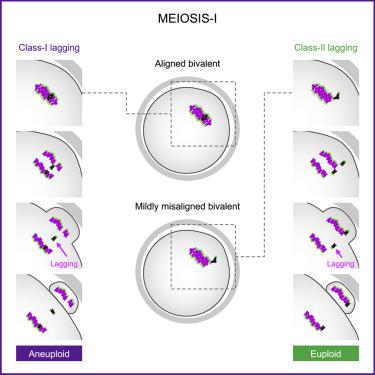Developmental Cell ( IF 11.8 ) Pub Date : 2021-08-23 , DOI: 10.1016/j.devcel.2021.07.022 Aleksandar I Mihajlović 1 , Jenna Haverfield 1 , Greg FitzHarris 2

|
Chromosome segregation errors that cause oocyte aneuploidy increase in frequency with maternal age and are considered a major contributing factor of age-related fertility decline in females. Lagging anaphase chromosomes are a common age-associated phenomenon in oocytes, but whether anaphase laggards actually missegregate and cause aneuploidy is unclear. Here, we show that lagging chromosomes in mouse oocytes comprise two mechanistically distinct classes of chromosome motion that we refer to as “class-I” and “class-II” laggards. We use imaging approaches and mechanistic interventions to dissociate the two classes and find that whereas class-II laggards are largely benign, class-I laggards frequently directly lead to aneuploidy. Most notably, a controlled prolongation of meiosis I specifically lessens class-I lagging to prevent aneuploidy. Our data thus reveal lagging chromosomes to be a cause of age-related aneuploidy in mouse oocytes and suggest that manipulating the cell cycle could increase the yield of useful oocytes in some contexts.
中文翻译:

不同类别的滞后染色体支持小鼠与年龄相关的卵母细胞非整倍体
染色体分离错误导致卵母细胞非整倍体频率随着母亲年龄的增长而增加,被认为是女性与年龄相关的生育能力下降的主要因素。后期染色体滞后是卵母细胞中常见的与年龄相关的现象,但后期落后者是否真的错误分离并导致非整倍体尚不清楚。在这里,我们表明小鼠卵母细胞中的滞后染色体包含两种机械上不同的染色体运动类别,我们将其称为“I 类”和“II 类”滞后。我们使用成像方法和机械干预来分离这两个类别,并发现 II 类落后者在很大程度上是良性的,而 I 类落后者经常直接导致非整倍性。最值得注意的是,减数分裂 I 的受控延长特别减少了 I 类滞后以防止非整倍性。


























 京公网安备 11010802027423号
京公网安备 11010802027423号